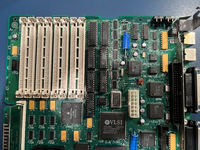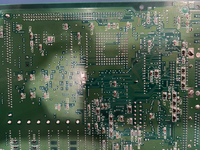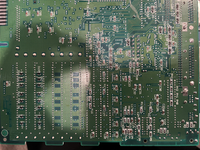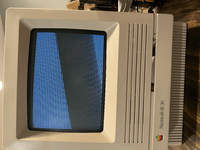So I had gotten this Simasimac SE/30 a while ago and tried to repair it. I posted about it on TinkerDifferent (https://tinkerdifferent.com/threads/simasimac-help-please.2842/#post-25938). I think I'm going to call this one unfixable, or at least not fixable by me. The SE/30, when shipped to me showed the typical pattern and had no chime. I then proceeded to recap it and got a happy Mac chime, but the same image on the screen. Having read a few things about SE/30 repairs before, I replaced UE8 with what I think is a suitable alternative (although a bit large for the area), but after doing so, I got crackling in the speaker and a black screen. I put the original one back... made no difference. I put another replacement on and I got a death chime. Only after leaving the screen on for about 20 minutes did the CRT jump back into life. Still had a simasimac pattern. I patched a few traces between the CPU and GLUE, GLUE and UB10 as well as UE 10 and a VIA as well as C6 capacitor and UB11. I'm not the best at soldering, so some of those broken traces/lifted pads were caused by me during the initial recap but some weren't. Anyway, since then, I've replaced all of UA8-UG8 and all of the F258s as well as UA9. Nothing. I then noticed that if I put pressure on one of the PAL sockets, that the screen would distort (video in the TinkerDifferent thread). I added some more solder to those pins as well as the 41264s... the screen never turned on again.
What's worse is that I just picked up a regular working SE to see if the analog board/power supply were to blame. After putting the SE/30 logic board in the SE case (with an extension), now the SE screen won't turn on even with the working SE board in it. So after that, I'd say these are going in a closet for a while. A shame because I've fixed so many other vintage computers in the past (M5126 Mac Portable, Color Classic, NeXT Cube, 128K). With this, it seems I'm over my head. I'll attach a picture of how the SE/30 board looks now... What do you all think?
What's worse is that I just picked up a regular working SE to see if the analog board/power supply were to blame. After putting the SE/30 logic board in the SE case (with an extension), now the SE screen won't turn on even with the working SE board in it. So after that, I'd say these are going in a closet for a while. A shame because I've fixed so many other vintage computers in the past (M5126 Mac Portable, Color Classic, NeXT Cube, 128K). With this, it seems I'm over my head. I'll attach a picture of how the SE/30 board looks now... What do you all think?





